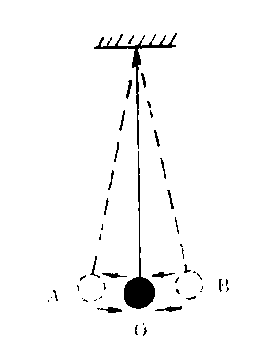周期zhouqi
长式元素周期表中每一横排元素叫做一个周期。每个周期包括元素种数都不一样,有短周期、长周期和不完全周期之分。
从原子结构观点来看,周期就是原子外层电子建层过程,即是原子中电子能级组的反映。同一周期中元素其原子必包含排布相同的能级组。周期的本质是按原子中能级组数目的不同对元素进行的分类。
元素所在周期数等于该元素原子最外电子层数或最高能级数,如钠最外电子层是第三层 (M层) 其最高能级组是第三能级组(3s3p),所以它是第三周期元素,各周期元素种数等于相应最高能级组所能容纳的电子总数。由于多电子原子中原子轨道能级交错的结果,每周期元素原子最外层电子数最多不能超过8个,次外层最多不能超过18个,都没有达到各个电子层电子最大容纳数2n2。反过来由元素所在周期也可推知其原子的电子排布层数。
周期zhouqi
振动系统完成一次全振动所需的时间。周期用T表示,单位是秒。简谐振动是严格的周期性运动,其周期是不变的常数。振动系统在一秒种内完成完全振动的次数称为振动的频率,常用f表示,单位是赫兹,简称赫。1赫(Hz)=1次/秒=1周/秒,周期和频率的关系为T=1/f。在广播用语中,频率的单位常用周、千周和兆周来代替赫、千赫和兆赫。频率f的2π倍称为圆频率,亦称角频率,用ω表示,其单位是弧度/秒(rad/s),ω=2πf=2π/T。简谐振动的圆频率就是旋转矢量法表示谐振动中参考点沿参考圆作匀速圆周运动的角速度。简谐振动的圆频率由系统本身的固有性质决定,所以一般叫做系统的固有圆频率,用ω0表示。相应地,简谐振动的周期、频率往往也称为固有周期、固有频率,用T0、f0表示。下面是常见的谐振子的固有圆频率。弹簧振子ωo= 。单摆ωo=
。单摆ωo= ,l为单摆摆长。复摆ωo=
,l为单摆摆长。复摆ωo= ,Pc为质心到轴的距离,I为复摆对轴的转动惯量,扭摆ωo=
,Pc为质心到轴的距离,I为复摆对轴的转动惯量,扭摆ωo= ,I为摆盘对轴的转动惯量,c是金属线的扭转系数。对于质点振动系统,根据fo=
,I为摆盘对轴的转动惯量,c是金属线的扭转系数。对于质点振动系统,根据fo= ,振动系统质量m愈大或弹性系数k愈小,固有频率f0就愈低,反之m愈小或k愈大,f0就愈高。动圈式扬声器振动系统的固有频率原则上服从这个公式,它的固有频率对于低频声学性能有十分重要的影响。通过增加系统的质量,即增加音圈与纸盆的质量或减小系统的弹性系数可以降低其固有频率,以扩展扬声器的低频范围。在阻尼振动中,振动物体或物理量在完成一次振动后不能完全恢复原状,其运动已不具有简谐振动的那种完全重复的周期性了。但为叙述方便,把相邻两次从同一方向经过平衡位置所经历的时间称为周期,其值为
,振动系统质量m愈大或弹性系数k愈小,固有频率f0就愈低,反之m愈小或k愈大,f0就愈高。动圈式扬声器振动系统的固有频率原则上服从这个公式,它的固有频率对于低频声学性能有十分重要的影响。通过增加系统的质量,即增加音圈与纸盆的质量或减小系统的弹性系数可以降低其固有频率,以扩展扬声器的低频范围。在阻尼振动中,振动物体或物理量在完成一次振动后不能完全恢复原状,其运动已不具有简谐振动的那种完全重复的周期性了。但为叙述方便,把相邻两次从同一方向经过平衡位置所经历的时间称为周期,其值为 ,式中β为阻尼因数,ω0=2π/T0为无阻尼时振动固有圆频率,T0为固有周期。上式表明,阻尼振动的周期由于阻力作用而大于无阻尼振动的周期T0。对于强迫振动,其周期是外力变化的周期。
,式中β为阻尼因数,ω0=2π/T0为无阻尼时振动固有圆频率,T0为固有周期。上式表明,阻尼振动的周期由于阻力作用而大于无阻尼振动的周期T0。对于强迫振动,其周期是外力变化的周期。
周期Zhouqi
振动物体完成一次全振动需要的时间。振动物体或振动量在经过一个周期之后,回复到开始的状态。例如,悬挂的摆锤往复运动,从O点开始,经A点、O点、B点,再回到O点作用的时间叫做一个周期(见图)。而从O点开始经A点回到O 点时所用的时间不是一个周期,因为在这段时间内摆锤没完成一次完全的振动。周期这个物理量是物体运动周期性的描述。简谐振动是严格的周期性运动,它的周期是一个常数。有些振动(如阻尼振动)的周期是不断变化的,严格地说,这种往复运动已不再是周期性的,但周期仍然能反映这种运动的往复情况。每个振动的物体,都有由它本身性质决定的、与振幅无关的周期,称固有周期。周期一般用T表示,单位为秒。

周期
❶物体完成一次全振动所经过的时间,通常用T表示。振动物体在经过一个周期之后,恢复到开始的状态。在阻尼振动中,振动物体不能完全恢复原状,则以连续两次以同方向通过平衡位置时所历时间为周期。
❷行波沿着波线传出一个完整的波形所需时间。在SI制中周期的单位为秒。
周期
在化学上常指元素周期表中每一横行的一系列元素。元素周期表共分7个周期。第1周期(只含2种元素),称特短周期;第2、3周期(各含8种元素)称短周期;第4、5周期(各含18种元素)称长周期;第6、7周期(含32种元素),第7周期(尚未全部发现)称特长周期。也有将第1、2、3周期称短周期,第4、5、6、7周期称长周期的。
- Accademia
- acceleration
- acceleration of free fall
- accelerator
- accelerator principle
- accelerometer
- accent
- accentor
- acceptance house
- accessory
- Accius,Lucius
- accomplice
- accordion
- accounting
- Accra
- Accrington
- accumulator
- acetaldehyde
- acetic acid
- acetone
- acetylcholine
- acetylene
- acetylenes
- acetylsalicylic acid
- Ach